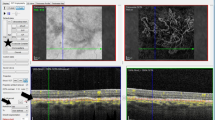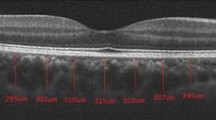Abstract
Purpose
The aim of this study is to image and describe the in vivo choroidal changes in various retinal dystrophies using the technique of enhanced depth imaging (EDI) optical coherence tomography (OCT) and to correlate these findings with the clinical appearance. Associations between choroidal change and genotype, visual acuity and results of retinal electrophysiology are also explored.
Design
Retrospective observational case series.
Methods
Twenty patients attending the medical retina clinics at Moorfields Eye Hospital underwent EDI OCT choroidal scans as part of the scanning protocol when they underwent OCT imaging with the Spectralis HRA and OCT. The choroidal images were obtained by moving the Spectralis camera close enough to obtain an inverted image of the retina. The scans were read by two experienced OCT readers assessing the choroidal thickness as well as the choroidal contour for focal areas of choroidal thinning corresponding to the areas of RPE/outer retinal atrophy. The spectrum of patients included those with Stargardt macular dystrophy, macular dystrophies secondary to known mutations such as peripherin/RDS, uncharacterised macular dystrophies, Best disease, bifocal chorioretinal atrophy, Bietti crystalline retinal dystrophy and choroideraemia.
Results
The choroidal appearance was symmetrical in all patients who had both eyes scanned. Ten patients showed no choroidal thinning, five had focal mild to moderate choroidal thinning, three had focal severe choroidal thinning, and two patients had diffuse severe choroidal thinning. There was no association between choroidal thinning and visual acuity [Fisher’s exact test, p = 0.350 (right eye), p = 1.000 (left eye)], or extent of retinal dysfunction on electrophysiology (Fisher’s exact test, p = 1.000).
Conclusion
Enhanced depth imaging using spectral domain OCT can be used to identify choroidal changes in inherited retinal disease. The pattern of choroidal change correlates well with the clinical appearance. It appears that the extent and pattern of choroidal thinning is dependent on the stage of the disease in some cases, and in others the causative gene defect.





Similar content being viewed by others
References
Oh KT, Weleber R, Stone E, Oh D, Rosenow J, Billingslea A (2004) Electroretinographic findings in patients with Stargardt disease and fundus flavimaculatus. Retina 24(6):920–928
Ashton N (1953) Central areolar choroidal sclerosis; a histopathological study. Br J Ophthalmol 37:140–147
Ferry AP, Llovera I, Shafer DM (1972) Central areolar choroidal dystrophy. Arch Ophthalmol 88:39–43
Voo I, Glasgow BJ, Flannery J, Udar N, Small KW (2001) North Carolina Macular Dystrophy: clinicopathological correlation. Am J Ophthalmol 132(6):933–935
Mura M, Sereda C, Jablonski MM, MacDonald IM, Iannaccone A (2007) Clinical and functional findings in choroideraemia due to complete deletion of the CHM gene. Arch Ophthalmol 125(8):1107–1113
Ayata A, Tatlipinar S, Unal M, et Ersanli D, Bilge AH (2008) Autofluorescence and OCT features of Bietti’s crystalline dystrophy. Br J Ophthalmol 92:718–720
Korte GE, Reppucci V, Henkind P (1984) RPE destruction causes choriocapillary atrophy. Invest Ophthalmol Vis Sci 25:1135–1145
Neuhardt TH, May CA, Wilsch C, Eichorn M, Lutjen-Drecoll E (1999) Morphological changes of retinal pigment epithelium and choroid in mice. Exp Eye Res 68:75–83
Saint-Geniez N, Kurihara T, Sekiyama E, Maldonado A, D’Amore P (2009) An essential role for RPE-derived soluble VEGF in the maintainance of the choriocapillaris. Proc Natl Acad Sci U S A 106(44):18751–18756, Epub
Wirtitsch MG, Ergun E, Hermann B, Unterhuber A, Stur M, Schloda C, Sattman HH, Ko TH, Fujimoto JG, Drexler W (2005) Ultrahigh resolution optical coherence tomography in macular dystrophy. Am J Ophthalmol 140(6):976–983
Ergun E, Hermann B, Wirtitsch M, Unterhuber A, Ko TH, Sattmann H, Scholda C, Fujimoto JG, Stur M, Drexler W (2005) Assessment of central visual function in Stargardt’s disease/fundus flavimaculatus with ultrahigh-resolution optical coherence tomography. Invest Ophthalmol Vis Sci 46:310–316
Lim JL, Tan O, Fawzi AA, Hopkins JJ, Gil-Flamer JH, Huang D (2008) A pilot study of Fourier-domain optical coherence tomography of retinal dystrophy patients. Am J Ophthalmol 146(3):417–426
Margolis R, Spaide RF (2009) A pilot study of enhanced depth imaging optical coherence tomography of the choroid in normal eyes. Am J Ophthalmol 147(5):811–815
Spaide RF, Koizumi H, Pozzoni MC (2008) Enhanced depth imaging spectral domain optical coherence tomography. Am J Ophthalmol 146(4):496–500
Povazay B, Hermann B, Hofer B, Kajic V, Simpson E, Bridgford T, Drexler W (2009) Wide-field optical coherence tomography of the choroid in vivo. Invest Ophthalmol Vis Sci 50:1856–1863
Ikuno Y, Kawaguchi K, Nouchi T, Yasuno Y (2010) Choroidal thickness in healthy Japanese subjects. Invest Ophthalmol Vis Sci 51:2173–2176
Ramrattan R, Van Der Schaft T, Mooy C, Brui** W, Mulder P, de Jong P (1994) Morphometric analysis of Bruch’s membrane, the choriocapillaris and the choroid in aging. Invest Ophthalmol Vis Sci 35:2857–2864
Godley BF, Tiffin PA, Evans K, Kelsell RE, Hunt DM, Bird AC (1996) Cinical features of progressive bifocal chorioretinal atrophy: a retinal dystrophy linked to chromosome 6q. Ophthalmology 103(6):893–898
MacDonald I, Russell L, Chi-Chao C (2009) Choroideraemia: new findings from ocular pathology and review of recent literature. Surv Ophthalmol 54:401–407
Cideciyan AV, Aleman TS, Swinder M et al (2004) Mutations in ABCA4 result in accumulation of lipofuschin before slowing of the retinoid cycle. A reappraisal of the human disease sequence. Hum Mol Genet 13:525–534
Acknowledgments
We would like to acknowledge Ms Genevieve Wright (genetics co-ordinator) and Ms Sophie Devery (genetics counsellor), Moorfields Eye Hospital for their help in obtaining molecular diagnoses of the patients from the database.
Funding
NIHR Biomedical Research Centre, Moorfields Eye Hospital and UCL Institute of Ophthalmology
Financial Disclosures
The Authors report no financial interests in the Spectralis HRA and OCT device used to obtain choroidal scans in the study
Study Approval
The study was approved by the Moorfields Eye Hospital Clinical Governance Committee (Approval Number: YEOHJ1002)
Author information
Authors and Affiliations
Corresponding author
Appendix
Appendix
Rights and permissions
About this article
Cite this article
Yeoh, J., Rahman, W., Chen, F. et al. Choroidal imaging in inherited retinal disease using the technique of enhanced depth imaging optical coherence tomography. Graefes Arch Clin Exp Ophthalmol 248, 1719–1728 (2010). https://doi.org/10.1007/s00417-010-1437-3
Received:
Revised:
Accepted:
Published:
Issue Date:
DOI: https://doi.org/10.1007/s00417-010-1437-3




